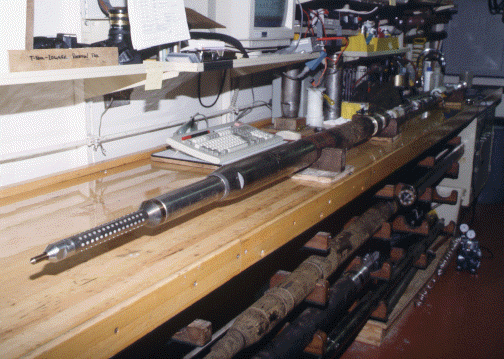Downhole Measurements Provided
Related Information:
Thermal Data Collection and Heat Flow Recalculations for ODP Legs 101-180
Supervising Scientist: Adam Klaus

Fluid Sampling
Water Sampling Temperature Probe
 Two or three water-sampling temperature probes (WSTP) are routinely available for sampling fluids ahead of the bit in sediments soft enough for the probe to penetrate without cracking. The WSTP is run on the coring line between cores and therefore requires a break in coring and drilling operations (perhaps as long as 2-4 hours, depending on water and hole depth and measurement plan) to collect a sample. The probe lands in the bottom-hole assembly (BHA) so that it extends up to 1 m into the sediment ahead of the bit; thus, the sediment to be cored next is disturbed. Fluid is drawn into the sample chamber (by the contrast between ambient [hydrostatic] pressure in the formation and surface atmospheric pressure initially trapped in the sampling system) through a series of titanium and stainless steel filters, and through the end of a 1/16-in. titanium sampling tube mounted near the tip of the probe.
Two or three water-sampling temperature probes (WSTP) are routinely available for sampling fluids ahead of the bit in sediments soft enough for the probe to penetrate without cracking. The WSTP is run on the coring line between cores and therefore requires a break in coring and drilling operations (perhaps as long as 2-4 hours, depending on water and hole depth and measurement plan) to collect a sample. The probe lands in the bottom-hole assembly (BHA) so that it extends up to 1 m into the sediment ahead of the bit; thus, the sediment to be cored next is disturbed. Fluid is drawn into the sample chamber (by the contrast between ambient [hydrostatic] pressure in the formation and surface atmospheric pressure initially trapped in the sampling system) through a series of titanium and stainless steel filters, and through the end of a 1/16-in. titanium sampling tube mounted near the tip of the probe.In open hole, the WSTP also can be used to sample borehole fluids ahead of the bit. In addition, Schlumberger tools for sampling open-hole fluids may be available through LDEO.
 Introduction
Introduction
 Pore-Fluid Sampling with the WSTP
Pore-Fluid Sampling with the WSTP
 Borehole Fluid Sampling with WSTP and Kuster Tools
Borehole Fluid Sampling with WSTP and Kuster Tools
Experimental Tools
The Fissler Experimental Water Sampler (FWS) was designed to combat two problems associated with the WSTP. One: it has a tapered point to minimize formation cracking on penetration and two: it utilizes a piston driven sampling system to slow the abrubt pressure change experienced by the WSTP which sometimes causes borehole fluids to be present in formation samples. Further work is required on the tool and future designs may include combination with the Davis-Villanger Temperature Probe (DVTP) which has a similar design and is discussed in the Formation Temperature Measurements section of the Downhole Measurements page.
